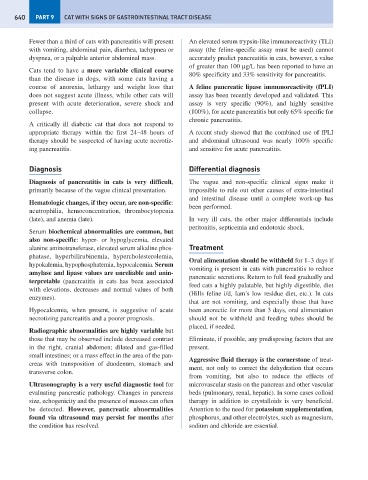Page 648 - Problem-Based Feline Medicine
P. 648
640 PART 9 CAT WITH SIGNS OF GASTROINTESTINAL TRACT DISEASE
Fewer than a third of cats with pancreatitis will present An elevated serum trypsin-like immunoreactivity (TLI)
with vomiting, abdominal pain, diarrhea, tachypnea or assay (the feline-specific assay must be used) cannot
dyspnea, or a palpable anterior abdominal mass. accurately predict pancreatitis in cats, however, a value
of greater than 100 μg/L has been reported to have an
Cats tend to have a more variable clinical course
80% specificity and 33% sensitivity for pancreatitis.
than the disease in dogs, with some cats having a
course of anorexia, lethargy and weight loss that A feline pancreatic lipase immunoreactivity (fPLI)
does not suggest acute illness, while other cats will assay has been recently developed and validated. This
present with acute deterioration, severe shock and assay is very specific (90%), and highly sensitive
collapse. (100%), for acute pancreatitis but only 65% specific for
chronic pancreatitis.
A critically ill diabetic cat that does not respond to
appropriate therapy within the first 24–48 hours of A recent study showed that the combined use of fPLI
therapy should be suspected of having acute necrotiz- and abdominal ultrasound was nearly 100% specific
ing pancreatitis. and sensitive for acute pancreatitis.
Diagnosis Differential diagnosis
Diagnosis of pancreatitis in cats is very difficult, The vague and non-specific clinical signs make it
primarily because of the vague clinical presentation. impossible to rule out other causes of extra-intestinal
and intestinal disease until a complete work-up has
Hematologic changes, if they occur, are non-specific:
been performed.
neutrophilia, hemoconcentration, thrombocytopenia
(late), and anemia (late). In very ill cats, the other major differentials include
peritonitis, septicemia and endotoxic shock.
Serum biochemical abnormalities are common, but
also non-specific: hyper- or hypoglycemia, elevated
alanine aminotransferase, elevated serum alkaline phos- Treatment
phatase, hyperbilirubinemia, hypercholesterolemia,
Oral alimentation should be withheld for 1–3 days if
hypokalemia, hypophosphatemia, hypocalcemia. Serum
vomiting is present in cats with pancreatitis to reduce
amylase and lipase values are unreliable and unin-
pancreatic secretions. Return to full feed gradually and
terpretable (pancreatitis in cats has been associated
feed cats a highly palatable, but highly digestible, diet
with elevations, decreases and normal values of both
(Hills feline i/d, Iam’s low residue diet, etc.). In cats
enzymes).
that are not vomiting, and especially those that have
Hypocalcemia, when present, is suggestive of acute been anorectic for more than 3 days, oral alimentation
necrotizing pancreatitis and a poorer prognosis. should not be withheld and feeding tubes should be
placed, if needed.
Radiographic abnormalities are highly variable but
those that may be observed include decreased contrast Eliminate, if possible, any predisposing factors that are
in the right, cranial abdomen; dilated and gas-filled present.
small intestines; or a mass effect in the area of the pan-
Aggressive fluid therapy is the cornerstone of treat-
creas with transposition of duodenum, stomach and
ment, not only to correct the dehydration that occurs
transverse colon.
from vomiting, but also to reduce the effects of
Ultrasonography is a very useful diagnostic tool for microvascular stasis on the pancreas and other vascular
evaluating pancreatic pathology. Changes in pancreas beds (pulmonary, renal, hepatic). In some cases colloid
size, echogenicity and the presence of masses can often therapy in addition to crystalloids is very beneficial.
be detected. However, pancreatic abnormalities Attention to the need for potassium supplementation,
found via ultrasound may persist for months after phosphorus, and other electrolytes, such as magnesium,
the condition has resolved. sodium and chloride are essential.

